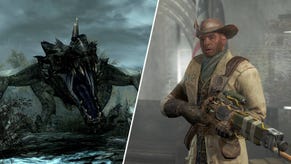Third-parties win E3 as show begins to lose relevance
And that was that. But what exactly was it? Patrick Garratt looks at the changing face of E3 and how 2011’s show shot well wide of the mark.
E3 week is our busiest of the year. Normally, Tokyo Game Show, GDC and gamescom pale in comparison on the hectic scale. E3, a show grounded on the need for publishers to show their goods to retail buyers in the lead into the holiday season, has become an annual touch-point for the global industry, traditionally showing us where we are and where we’re going in the coming years.
Unfortunately, though, huge shifts in the way the games industry operates recently left E3 2011 failing to deliver on these criteria, and yet another question mark over the validity of the show itself.
In truth, E3 2011 wasn’t that busy.
Weak showings from the platform holders this year gifted centre stage to third-party software publishers, with a pack-leading quartet of EA, Bethesda, Square Enix and Ubisoft stealing major headlines with its triple A line-ups.
If a single company typified just how lost E3 has now become in a world of explosive game growth outside of the traditional business channels, it was Activision. The largest games publisher in the world barely registered at E3 2011, its single, major showing being Modern Warfare 3, the pillar franchise it has most intrinsically connected to the traditional console-disc model.
The biggest third-party barely had to bother with E3. That there is a huge disconnect between videogaming’s “real world” and ESA’s LA showcase is now undeniable.
Failing to Kinect
Microsoft's press conference set a precedent for what is essentially a lack of direction from the console manufacturers. The Xbox 360 conference is typically a shotgun-acceleration into E3 week, a chance for the green machine to leverage its US credentials and steal the show, but a heavy leaning on Kinect made for a missed opportunity.
From a news perspective, there were scant headlines to be had. Microsoft’s first-party core titles are strong, but we’ve seen them all before. We got new looks as Gears 3 and Forza 4, which, while fantastic-seeming, are unquestionably more of the same. That the Halo 4 announcement leaked before the conference summed it all up: the slip wasn’t that exciting, and the reveal trailer showed virtually nothing. The Halo CE HD remake looked cool, but we really are preaching to the choir here. In terms of “innovation,” the needle’s on empty.
It was hugely telling that Microsoft chose to open its showcase with two third-party titles, Modern Warfare 3 and Tomb Raider. The Infinity Ward shooter looked so familiar it was frightening. Tomb Raider drew deserved plaudits from the show in general, for two reasons: firstly, its general quality as an atmospheric action game looked first-class; secondly, Crystal Dynamics has torn up the IP’s rulebook and done something new with it (much to the chagrin, I might add, of many female journalists speaking in private over the week, miffed that gaming’s power lady has aparently been reduced to a teenage victim - you can’t please them all).
Xbox 360’s first-party core exclusives this year are Gears 3 and Forza 4. As commendable as those games are, is that really enough to prop up Microsoft’s claim of 360 as the gamer’s choice?
“OnLive’s going to win. Dead serious. Another three years and all this will be over. I’m calling it.”
After the core software, Microsoft moved into Kinect mode. Ubisoft showed Ghost Recon running with Kinect features, and Mass Effect 3 was confirmed as having Kinect-based voice control functionality. In reality, these are both examples of publishers making hedged bets on Kinect, by including non-essential motion and voice features into large, straight-genre projects. We’ve heard a great deal about how E3 this year was supposed to show why Kinect matters to the core: that didn’t happen. You will not need to buy a Kinect peripheral to play any major core game in the foreseeable future.
Lionhead finally showed its Kinect project, revealing Fable: The Journey. Keza saw this the following day and was impressed with it, but I can’t help being hopelessly depressed that Molyneux has been reduced from working on Milo & Kate, a game that looked set to change the face of modern console gaming forever, to a Fable action off-shoot in which you throw spells and draw lines in the sky. Can’t really see Fable: The Journey being demoed at TED, can you?
Kinect is being forced onto existing genres, instead of becoming a genre in itself. Microsoft announced Bing and YouTube Live integration, and trotted out new voice commands for the 360 dash this year. Minecraft was announced for 360 this year, but it’s not being made by Notch.
It truth, as the curtain fell on the Microsoft E3 2011 press conference, we were left sitting with a string of mediocre announcements and the promise of Kinect dashed on the rocks of retail reality.
Vita, Vita, Vita
Sony was better, mainly because it was disarmingly honest about the PSN balls-up, announced an excellent price for the upcoming PS Vita, and didn’t make everyone vomit with its choice of name for the next gen handheld.
Uncharted 3 did suffer from the same signs of IP fatigue as Gears and Modern Warfare, but there’s no denying its quality. Resistance 3, again, was in the same area: it looks great and we’re seeing technology boosts over previous instalments, but this is the third game for this IP in this generation. If you didn’t get on with the previous two, you’re not about to be thrilled by this now.
Sensibly, Move was pushed off into its own section as opposed to being a central tenate of Sony’s entire showing, as Kinect was with Microsoft. SCEE boss Andrew House was honest about how Sony feels about Move in an interview with VG247 during the show, saying the motion controller wasn’t the “be all and end all” for the company.
Sony did announce a couple of decent content exclusives, both of which, incidentally, included Move support. BioShock: Infinite, without doubt one of the most enticing core prospects at the moment, and Dust 514, the CCP EVE tie-in, will be PS3 natives, the latter only being available on the console. And it’s getting a Vita version.
Need for Speed: The Run, Saints Row the Third, Star Trek, Battlefield 3 and SSX will all have exclusive content for PS3. That’s not bad.
Vita was the jewel in Sony’s crown, though. It won’t be out in Europe and the US this calendar year from the sound of it, but it does look brilliant and it will be affordable at $250.
Overall, Sony was just tighter and more convincing than Microsoft, and appeared to be a company that isn’t afraid to say when it’s wrong and focus on the stuff it gets right. There’s a lot to be said for that.
Wii U please close the door on the way out?
Nintendo, unbelievably, fumbled the Wii U announcement. It should have been one of the most exciting reveals in recent years, but a lack of clarity and a steadfast refusal to emerge into a modern world of constant internet connection and social interaction left Nintendo’s share price in tatters and its top brass baffled.
Nintendo focused solely on Wii U’s controller during the presentation, saying it wanted explain the machine’s point of differentiation to other console hardware, and left both media and punters alike wholly confused about what Wii U even was until it released official hardware shots of the box itself, but only after the press conference.
While the console itself was fleetingly shown during the presentation, sitting under a TV in a demo reel, various news outlets - including us - reported that Wii U was a tablet. It wasn’t until we saw the machine in the photos and spoke to Keza afterwards - she played with Wii U just after the reveal - did we realise there was an actual console at all.
Confusion aside, Wii U should have shown us what the shape of videogaming will look like over the next 5-10 years. It didn’t. Wii U has no hard drive, so it’s clear Nintendo is, yet again, refusing to admit the internet exists, and only one tablet controller can be connected to a single machine at once. Some of the off-the-record comments coming out of the show after playing with Wii U are unrepeatable, but let’s just say they weren’t exactly complimentary.
Nintendo is a leader in this industry. It has a responsibility to lead. It has a responsibility to provide both business opportunities for the wide trade and excitement to users. I don’t believe it did either with its Wii U announcement, and I can’t help feeling that few people will be fooled by what is an obvious attempt to position Wii U behind next gen PlayStation and Xbox consoles in a technical sense for the upcoming cycle. We have seen this before.
We’d seen virtually everything at E3 2011 before.
Third-party win
A general lack of confidence from the platform holders did have an upside: it shone focus on a cluster of third-party publishers all pushing for dominance as the games industry consolidates. EA, Bethesda, Square Enix and Ubisoft all came to E3 will some terrific games, with Skyrim, Tomb Raider, Battlefield 3 and Far Cry 3 my picks for the show.
All of these games are pushing the boundaries in some form, whether it’s technically or in terms of content. Battlefield was just full stop stunning: that’s the next generation, right there; Skyrim, barring some kind of disaster, will take the entire concept of the offline RPG to a new level; and Tomb Raider has shown that Square Enix isn’t afraid to take one of the largest IPs in games and essentially turn it into an adult horror. It’s brave: we need bravery.
Far Cry 3 was one of the show’s few surprises, and didn’t disappoint. It’s a big budget, open world shooter focused on genuinely adult themes. Try naming another one.
But while this small group of large companies dropped some incredible-looking software on LA this year, the malaise we irrefutable. We did not see a general way forward. Wii U is not it. As one well respected journalist said to me in the aftermath, “OnLive’s going to win. Dead serious. Another three years and all this will be over. I’m calling it.”
What we saw at E3 this year was a mid-cycle dead-zone. With digital sales now accounting for more than 40 percent of all games revenue and set to go past the halfway mark this year, where was the acknowledgment? Where was the day-date download release, the cross-platform integration? Where was the excitement of the next frontier?
If E3 was built on a bedrock of selling discs to stores for Christmas, how is it maintaining relevance in a world where we’re about to see the majority of sales go to digital distribution and the year has become a homogenised release schedule?
The quick answer is that it isn’t, but it can. It emerged in the wake of the show that ESA’s contract with the LACC is to end next year, and that it may have to move E3. As I’ve been saying for years, there’s an opportunity to throw off the shackles of the “old” E3, move it to a more suitable location - like Las Vegas - and embrace the gamescom and TGS format of a business event coupled with a consumer show. The North American games market is the biggest in the world: it needs to be excited. Videogaming is becoming less about platforms and all about content. ESA, in my opinion, should be showing that content to consumers in an appropriate setting, whether it’s on a computer screen, a mobile phone or a 3D HD TV, and telling them why they should be preparing to spend money on videogames as entertainment, for all our sakes.
If E3 doesn’t change with the consumer, it will cease to matter to the trade, the consumer, the content creators and the media. Let's hope we never get there.











